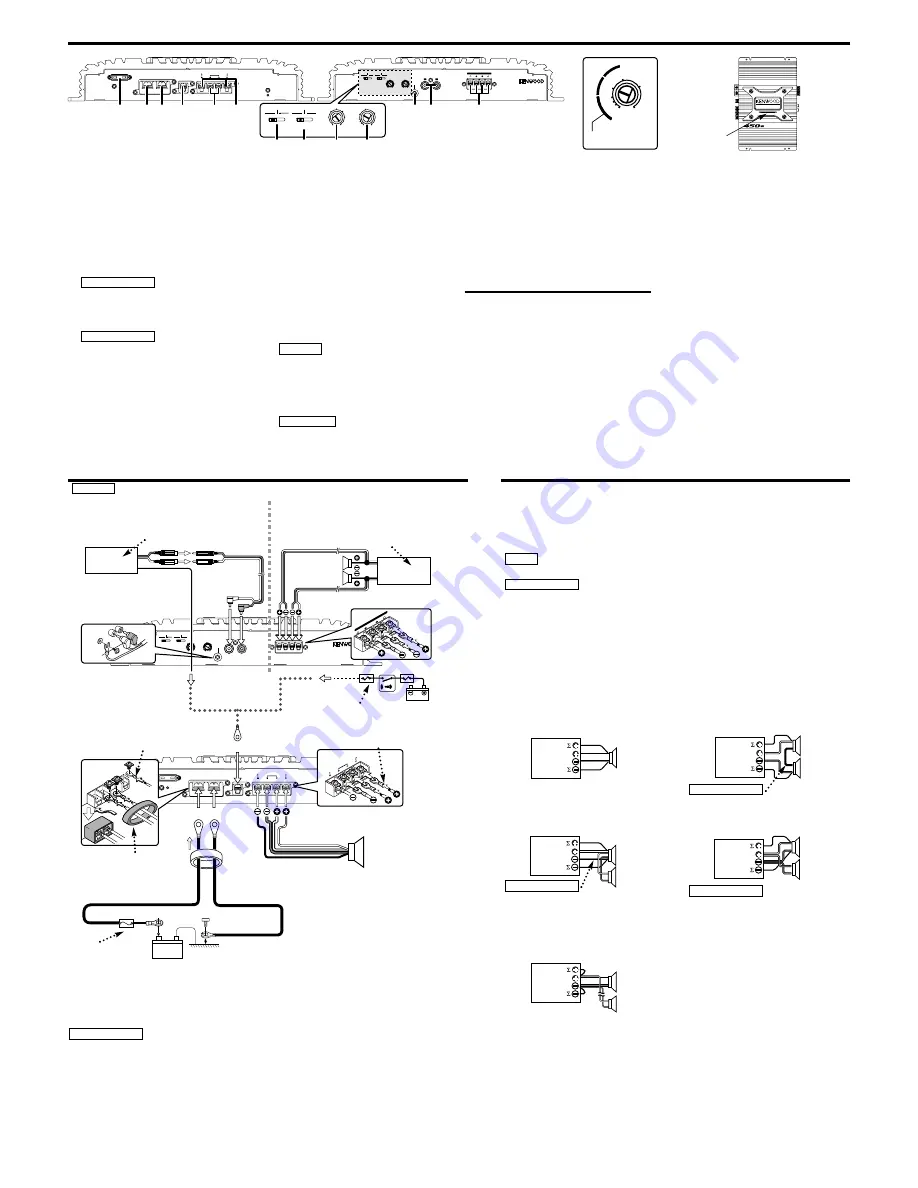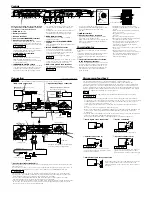
25Hz
15Hz
OFF
INFRASONIC
GND
INPUT
SENSITIVITY(V)
LPF
FREQUENCY(Hz)
L
R
LINE IN
LEFT
RIGHT
SPEAKER LEVEL INPUT
12dB
6dB
OFF
BASS
BOOST
0.3
0.5
1
2
3
4
5
0.2
150
120
170
100
70
50
200
SUBWOOFER
AMPLIFIER
POWER IN
FUSE (30A)
BATT
GND
P.CON(REMOTE)
SPEAKER OUTPUT
30
SERVO
II
·
SERVO
II
·
GN
D
LE
FT
RIG
HT
SPEAKER LEVEL INPUT
4
2 3
!
#
56
-
+
SPEAKER OUTPUT
SERVO
II
·
SERVO
II
·
Operations of the following control and switches
are required in accordance with the centre unit
and speakers connected with this unit.
1
FUSE (30 A
´
1)
2
Battery terminal
3
Ground terminal
4
Power control (REMOTE) terminal
5
Speaker output terminals
As this unit accepts speakers with a minimum
impedance of 2 ohms, connect speakers with
2-ohm or higher impedance to these terminals.
The rated input of the speakers should be no
less than the maximum output of the amplifier.
Otherwise malfunction may result.
6
SIGMA SERVO
II
terminals
Be sure to make proper connections to the
SIGMA SERVO
II
terminals. Incorrect
connection may result in lack of sound output
or other malfunctions.
7
INFRASONIC FILTER switch
Ultralow frequencies that cannot be reproduced
even by a subwoofer speaker do not become
sound but become unnecessary oscillations,
which affect the sound by causing distortion,
etc. Setting this switch to "15 Hz" or "25 Hz"
cuts the frequencies below the respective
frequency.
This improves the reproduction performance of
the speakers by eliminating unnecessary
oscillations which will not become sound.
8
BASS BOOST switch
Setting this switch to "+6dB" or "+12dB"
emphasizes the bass.
9
LPF(Low-Pass Filter) FREQUENCY
control
This control adjusts the frequency band output
from this unit.
0
INPUT SENSITIVITY control
Set this control according to the pre-output
level of the center unit connected with this
unit, or to the maximum power output of the
genuine-accessory car stereo.
Use the diagram on the right as a guide.
For the pre-output level or the maximum power
output, refer to the “Specifications” in the
instruction manual of the center unit.
!
RCA cable ground lead terminal
When using an RCA cable with a ground lead
attached, connect the ground lead to this terminal.
Do not use this terminal for power source
grounding. This unit will be damaged if the power
source grounding wire is connected to this
terminal.
@
LINE IN terminal
#
Speaker level input terminals
A center unit with no RCA output can still be
connected to the speaker output.
Again, even without a power control signal, the
power is switched ON/OFF automatically by
the speaker signal.
Power indicator
When the power is turned on, the Power indicator
lights.
If the Power indicator does not light when the power
is turned on, the protection function may be
activated. Check whether there is any indication of
trouble.
■
The protection function is activated
in the following situations:
This unit is equipped with a protection function
for protecting this unit and your speakers from
various accidents or problems that can occur.
When the protection function is triggered, the
Power indicator goes off and the amplifier
stops operating.
• A speaker wire may be short-circuited.
• A speaker output may be in contact with the
ground.
• When the internal temperature is high and
unit won’t operate.
• The sigma servo connection may be
erroneous.
• The fuse of this unit may be blown.
• The unit may be malfunctioning and sending
DC signal to the speaker output.
• The grounding wire of this unit may not be
connected with a metallic part which is
electrically connected with the negative
terminal of the battery.
• The power control wire may not be connected
to this unit.
• The grounding wire of the centre unit
(cassette receiver, CD receiver, etc.) may not
be connected with a metallic part which is
electrically connected with the negative
terminal of the battery.
2
CAUTION
NOTE
2
CAUTION
2
CAUTION
0
SUBWOOFER
AMPLIFIER
KAC-819
25Hz
15Hz
OFF
INFRASONIC
GND
INPUT
SENSITIVITY(V)
LPF
FREQUENCY(Hz)
L
R
LINE IN
LEFT
RIGHT
SPEAKER LEVEL INPUT
12dB
6dB
OFF
BASS
BOOST
0.3
0.5
1
2
3
4
5
0.2
150
120
170
100
70
50
200
SUBWOOFER
AMPLIFIER
POWER IN
FUSE (30A)
BATT
GND
P.CON(REMOTE)
SPEAKER OUTPUT
30
SERVO
II
·
SERVO
II
·
MAXIMUM POWER
25Hz
15Hz
OFF
INFRASONIC
INPUT
SENSITIVITY(V)
LPF
FREQUENCY(Hz)
12dB
6dB
OFF
BASS
BOOST
0.3
0.5
1
2
3
4
5
0.2
150
120
170
100
70
50
200
0.3
0.2
0.5
1
2
3
4
5 (V)
(W)
15
10
1
@
2 3
4
!
5
6
#
8
9
0
7
Power indicator
Terminal cover
Battery
Ground wire*
Battery wire*
Protective Fuse*
Connection
For safe installation, read "Installation procedure" before starting work.
NOTE
CENTER UNIT
(Cassette receiver,
CD receiver, etc.)
Power control wire*
RCA cable*
Genuine-accessory car stereo
(No
line output center unit etc.)
ACC
Battery
Car fuse box
Lead terminal*
Subwoofer
Lead terminal*
Speaker
■
RCA cable connection
■
Speaker level input connection
*…Commercially available parts
25W or greater
Sigma servo feed back
The sound reproduced through conventional amplifiers is distorted due to the
counterelectromotive force produced in the oscillating system of the speaker. The
counterelectromotive force is particularly high with the woofer which requires a large drive
mass.The sigma servo connection reduces distortion caused by the counterelectromotive
force by including the circuit up to the speaker terminals in the negative feedback loop. This
makes it possible to drive speakers with more fidelity to the input signals and create a sharp
bass sound image with few feeling of noise interference.
The speaker wires and sigma servo wires should be distributed along the same paths.
• The extension of the negative feedback loop to include the speaker terminals makes it
necessary to connect the sigma servo terminals correctly. Incorrect connection may result in
sound degradation or other malfunction. If sound is not reproduced normally, check the
connection of the sigma servo terminals, etc.
• If the Sigma servo terminals are not connected, the sound may fluctuate or noise may
occur.
Be sure to connect the Sigma servo terminals correctly.
• When connecting speakers in a parallel configuration, use speakers with an impedance of 4
ohms or more. Connecting speakers with smaller impedance than 4 ohms will cause
malfunction.
• The rated input of the speakers connected to this unit should be no less than the maximum
output of the amplifier. Otherwise malfunction may result.
Be specially careful in this when connecting speakers in a parallel configuration.
2
CAUTION
NOTE
Distribute the speaker wires and sigma
servo wires along the same paths.
■
Basic sigma servo connection
■
Series connection
Make this wire as short as possible.
2
CAUTION
■
Parallel connection (1)
The speaker wires connected to this unit
should be thick enough to supply the current
capacity of two speakers.
2
CAUTION
This connection is possible only when the
speakers are identical and the speaker
wires are also of the same type and length.
2
CAUTION
■
Simplified sigma servo connection
■
Parallel connection (2)
In case any of the connection examples above cannot be
used or if the speakers cannot be connected to the
speaker terminals, connect them to this unit as shown in
the figure.
■
Speaker level input terminals (
#
)
When the genuine-accessory car stereo power is turned ON/OFF, check that the power to this unit
has followed suit.
In some cases, the power control is not correctly operated by the genuine-accessory car stereo. If
this is the case, connect the ACC or power control signal to the P.CON(REMOTE) terminal.
• The genuine-accessory car stereo shall have a maximum power output of no more than 40 W.
• Do not connect the speaker output leads from a power amplifier (Optional) to the speaker level
input terminals of this unit, for this may cause malfunction or damage.
• Do not connect cables and leads to both RCA cable input jacks and the speaker level input
terminals simultaneously, for this may cause malfunction or damage.
• Connect the power control lead to a power supply which can be turned ON/OFF by the ignition key
switch (ACC line). With this connection, shock noise may be generated when the power of the
genuine-accessory car stereo is switched ON/OFF.
2
CAUTION
Controls




















